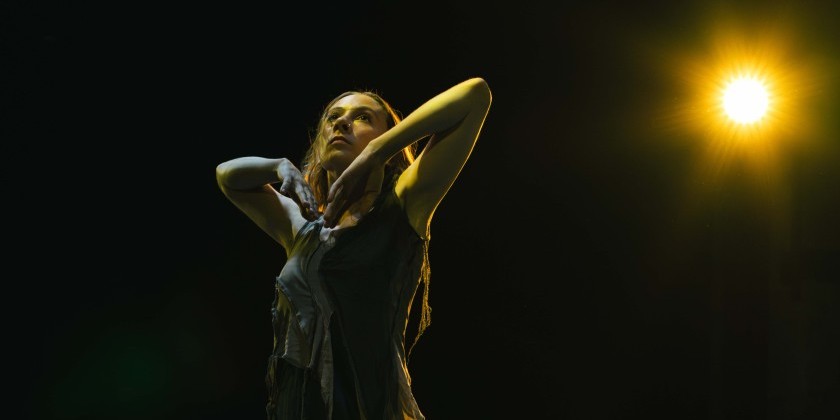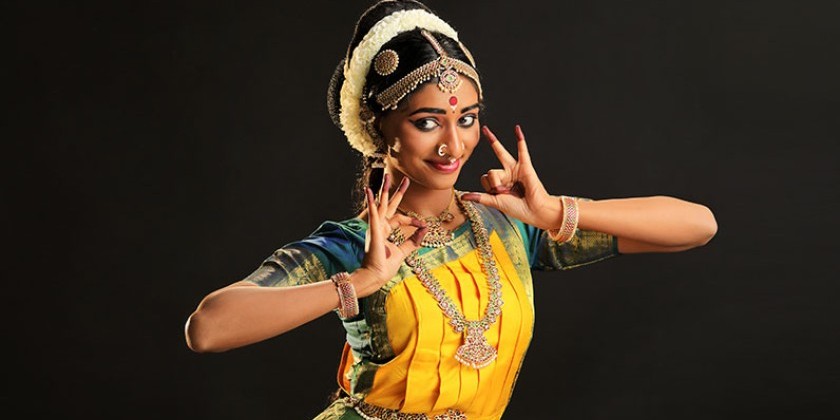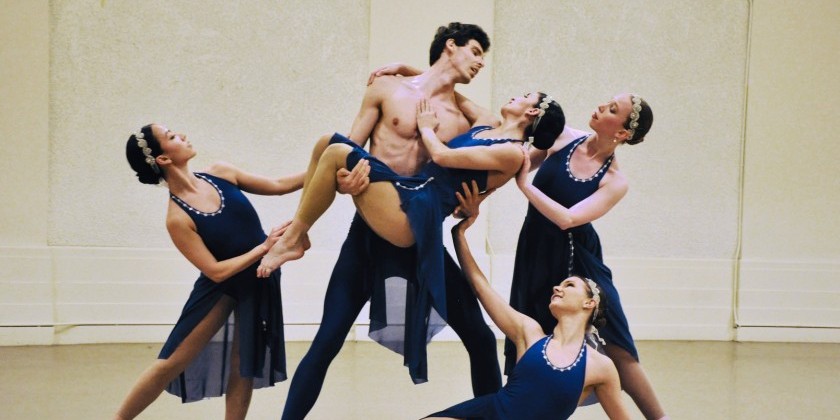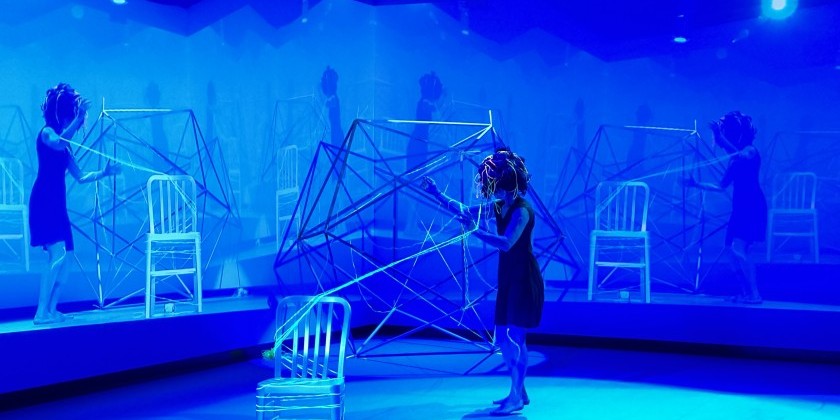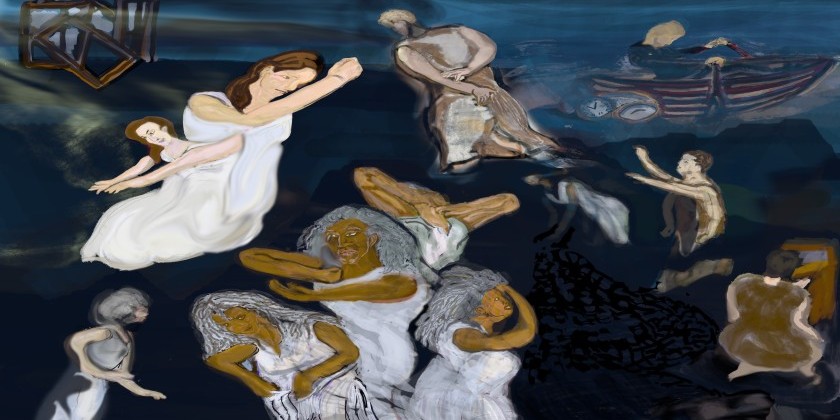AUDIENCE REVIEW: Performance Mix Festival: 33 at New Dance Alliance
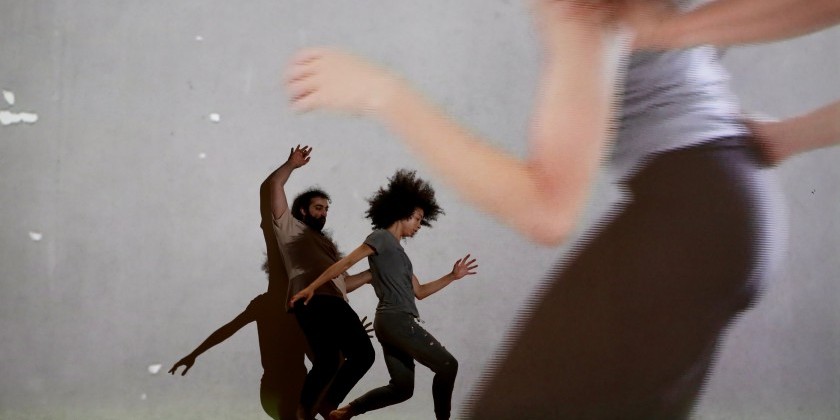
Company:
New Dance Alliance
Performance Date:
June 6-9, 2019
Freeform Review:
Performance Mix Festival: 33, held June 6-9 at University Settlement, was an exciting mix of dance and performance from the U.S., Quebec, and Norway. Talk about diversity! We had it: age, race, background and―dare I say it―context, my word for all the brave ideas put before us using so many layers of dance, theatre, media, and methods.
The first reviews were written by Alice Klugherz while the review of Alice’s Chaos, a work in progress about a life in process, is by Jane Goldberg.
In Collapsing Distance, choreographers Siri Jontvedt and Snelle Hall (visiting artists from Oslo, joined by dancers Katarina Eriksson and Johanna Meyer) are by turns professorial, defiant, resigned, glamorous, and self-conscious in a series of whimsical vignettes about the experience of growing older. The many memorable scenes we are treated to include meditative sitting by a “campfire,” a struggle to get into evening gowns, followed by a wild romp in which the gowns come off, and a virtuosic hula-hoop interlude (by Meyer). Although the women bring up the dispiriting aspects of getting older, such as depression and injury, these highly engaging and relatable performers are ultimately infectiously joyful.
In Strange strangers, Audree Juteau and Nate Yaffe (visiting artists from Quebec) melt off chairs and relax into a huge drop cloth, taking the set with them. As they move, the stage floor turns into a large reactive sinkhole. Somehow they make their way under the cloth and, like ghost cats on hoverboards, they float underneath. It’s one slow tornado―they move the set and the set seems to move them. I saw it twice. For the beautiful dancing in service of the piece, I’d watch it again.
In Michele Beck’s Moving Bodies, Stacy Lynn Smith and Alex Romania respond to a video of dancers being placed and replaced. The palate is gray. The video and dancers, moving in and out of the video, are not doing the same thing. The dialogue is abstract and captivating.
In the Traveler and the Thief, created and performed by Linda Austin and Allie Hankins, absurdity, nonsense songs, and unrelated topics are connected by movements, gestures, and stillness, and punctuated by a flashlight that circles on a Roomba-like rotating prop. Gertrude Stein meets postmodern madness: joyful, surprising, and fun.
'Kopfkino' is a German word that means head cinema―the movie that plays inside your head, perhaps beyond your control. The dance piece Kopfkino, choreographed by Stuart B Meyers and performed by Meyers and Hannah Jean Hildreth, takes place in a graveyard. Are we flies on a tree next to a freshly dug grave? Or are we on the set of the original vampire movie (between takes) with Mr. and Ms. Nosferatu? Too riveted for our thoughts to wander, we witness the movement-opera of what becoming a vampire is really like.
In the beginning he sits on the floor and she is lying down with her head on his lap. She is in a nightgown―or is it a wedding dress? It’s not hard to follow, it’s just hard to explain. She’s staring into space, seemingly already bitten by a prior, “off-screen” attack. He feels the pulse on her neck as he contemplates another bite. Just how many bites does it take? The piece is more about their specific connection and her crossover than the recipe―the process has already begun.
When the portal opens we are in the middle of her transformation. Their relationship is etched in freezes, locks, and pops, expressing attachment, conflict, and second thoughts. We see her thinking, “Do I really want to be a vampire? Do I really want to be Mrs. Nosferatu?” She’s mad at him, she’s in love with him… she’s human.
He is connected, embodying empathy, to her moves from across the room. Like a finger in a socket they are making the negative space light up and crackle as the virus ricochets through her. The dancing is super-modern but has the jerky quality of the first silent films; everything new is old again in this detailed, entertaining vision.
Both dreamy movers are completely committed to every angle they find themselves in. Meyers is a vampire and Hildreth is becoming one in this movie—I mean, dance piece. Kopfkino was conceived in the studio and in Meyers’s head as a dance, but now, unerasably in my mind, it is my Kopfkino—the movie inside my head.
In Vinegar Spirit, Britta Joy Peterson and performers create another kind of feminine sparkle but with a costume that hides their torso from neck to knees. Even when they are not in unison, they come off as one being: insistent, fast-paced, and entertaining. I feel like I am watching a new kind of insistent rhythm. I don’t know what they are cheering for, but I am right there with them.
In The Neptune Room, theatre and dance lie side by side; and this juxtaposition, done with so much skill, draws us in. Male and female actors in the NYC uniform—all black or at least very hip (the best of The Gap and Eileen Fisher)—gossip with each other in unfinished sentences about people who are not present. They know what they’re talking about, and even though we don’t, it’s mega fun to listen to. We are all familiar with it—although we don’t think we sound like that. All the while, there is some seriously good dancing by the choreographer, Doug LeCours, and dancer Tim Bendernagel going on just behind, and sometimes near the gossiping group, but never quite interacting with it.
Towards the end, the people in black are sitting in front of us doing a talk-back with us—but not really. They respond to our imagined questions and feedback with the convoluted eye-rolling art speak we all know too well. And that is when the whole thing seems to tie itself into a perfect bow. We go from being a witness/audience member to playing the audience in “the work” and it’s funny and brilliant.
The second to last piece, Patrick Quinn’s Must Go On, is just so extreme, it keeps taking us to higher places of sheer delight. There are 35 vigorous scenes and costume changes on this roller coaster of a piece! Performed by Quinn and his dresser and fabulous enabler Matthew LaCoste, it’s like glorious fireworks, you just keep smiling (and screaming). It keeps getting more fabulous! One moment says it all, as there is yet another great slide onto the floor by Quinn. This one seems to be called “just passed out on the couch,” and if there was any doubt, LaCoste pours a zillion empty beer cans on top of him.
The sheer humor and vulnerability of these two, the endless no-two-falls-alike by Quinn, the love and care expressed by LaCoste, lead to a heartrending feeling of being sure you are in the right place at the right time, watching greatness. Everyone fell in love with these two, whose actions and style are way beyond category; dance, comedy, theatre—a thousand “endings” in one night—just check all the boxes! We will follow them; I’ll return your money if you don’t agree.
During Sunday’s performance there were three durational performances. In Teaching a Human the Urban Weeds Alphabet, the choreographer, Andrea Haenggi, dances with plants—gaining moves from their growth and life cycle. Audiences experience what she is doing in tight circles that both watch and move with her. There are plants in the space as well as drawings—careful renderings of the plants’ growth and choreography.
In David Knox’s The Reflection We Carry, Knox and Justin Keats carefully carry a large mirror up University Settlement’s spiral staircase from the from the first floor to the roof, accompanied by Nicola Mills’s singing. As the mirror ascends it reflects the audience and one of the most beautiful features of University Settlement, the spiral staircase.
Vitche-Boul Ra's durational piece Ulk-RaHa bo-la Proxie Ghahnge was done in the gym, a huge space with high ceilings on the top floor of University Settlement. His costume was simple: shorts, sneakers and a t-shirt. One long dread curves down his back and wraps around his torso and waist. A choice was made not to add the movement of his hair to the occasion. It appears like a purposeful decoration that is also part of him.
He is deliberate, focused, and original. The sound is a human voice, done both live (by Vitche-Boul Ra) and on tape, words drawn out or scream-sung. Continual percussive sounds—sometimes sparse and sometimes like an ongoing machine—join the human voice. And although his tremendous facility as a dancer is revealed, it is completely in service of a gesture. And there are many such gestures, most of them just slightly different than you remember them; for example, instead of the whole hand going to his face with a palm cradling his forehead, a gesture we are all familiar with, he puts the side of his hand on his forehead and this grows into a slow descent to the floor.
He needs all the space but he makes no attempt to fill it, even when he walks around most of its perimeter. By controlling the distance, he creates a buffer zone between himself and us. The facial expressions are genuine, but I have no frame of reference for what they mean. A smile does not seem like a smile in the world he is in.
Partway into the work he animates one fan with another by pointing the one that is plugged in towards the other so that both are spinning. He takes the cord of the fan that is not plugged in and pulls it; when he puts the plug in his mouth, it’s erotic—not as an object that is a stand-in for a body part, but because he animated it. He’s the electricity. Vitche-Boul Ra is a triple threat, an accomplished dancer, choreographer, and fine artist.
On Alice Klugherz by Jane Goldberg
A highlight of the festival was Alice Klugherz as Alice in Wonderland in Chaos, a work in progress about a life in process. How perfect was her costume of apron and playing cards of kings and queens and jacks as she pulled out her white rabbit and fell down the hole? Discussions ensued about her family’s cocktail parties, being a free range kid running through neighbors’ yards, and relationships that are on again, off again. The sheets of paper she spread in front of her, trying to be organized and remember her lines, weren’t needed.
Her piece flowed continuously. How online dating at 64 is awful and how impossible it seems, and on and on with Klugherz’s multi-faceted life unfolding to the end when she admits therapy doesn’t result in cure, but in awareness. All the things she can’t do to clean her own apartment, even though she can do others’ and make a living at it! She said she should be a housewife but to me, she is too creative a thinker for just taking care of chores and domestic duties. This Alice is the real-life version of the one in Alice In Wonderland and Through the Looking Glass combined, wondering and wandering through her life. The irony of such a structured piece with so many anecdotal touching moments blew my mind.
More information about the artists: http://newdancealliance.org/performance-mix-festival/past/2019-performance-mix-festival/
Author:
Alice Klugherz and Jane Goldberg
Website:
newdancealliance.org
Photo Credit:
Michele Beck's Moving Bodies. Photo by Kathryn Butler






